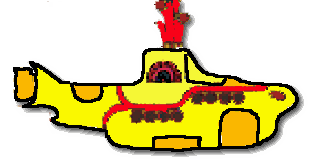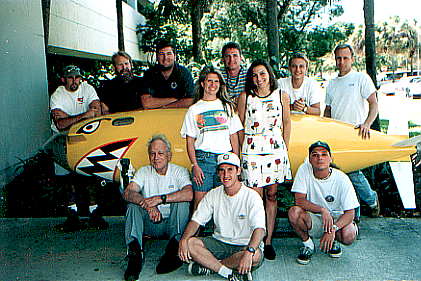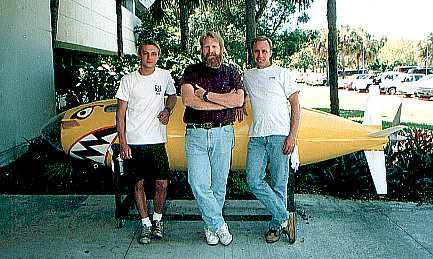|
 The International The International
Human Powered
Submarine Races
by Dr. Ray McAllister
 There are two separate types of Human Powered Submarine Races. The toughest, because the subs must compete against each other in the ocean, with waves, currents and visibility potential problems, was held off Riviera Beach, FL in 1989, again in 1991 and off Fort Lauderdale in 1993. The seconbd type of race is held in an inland tow tank, like the Escondido, CA Offshore Model Basin, 100 m long and 5 m deep. The latter is a race against time and has slightly different rules considering the very safe nature of the event. This latter race series is called the World Submarine Invitational and is held approximately every other year, the winner in the one person and two person craft being entered in the Guiness Book of Records. More on this later. There are two separate types of Human Powered Submarine Races. The toughest, because the subs must compete against each other in the ocean, with waves, currents and visibility potential problems, was held off Riviera Beach, FL in 1989, again in 1991 and off Fort Lauderdale in 1993. The seconbd type of race is held in an inland tow tank, like the Escondido, CA Offshore Model Basin, 100 m long and 5 m deep. The latter is a race against time and has slightly different rules considering the very safe nature of the event. This latter race series is called the World Submarine Invitational and is held approximately every other year, the winner in the one person and two person craft being entered in the Guiness Book of Records. More on this later.
The 3rd International Human Powered Submarine Races were held off Bahia Mar, on the Fort Lauderdale Public Beach, from 16 thru 27 June, 1993. It was even more International this year than either of the last two races, with a Russian team of about 20 expressing interest but failing to make it at the last moment, plus a Canadian entry, an entry from the UK, a German entry and about 40-45 American entries from almost as many states.
The Russians called Dr. Dunn, of the Florida Atlantic University, Department of Ocean Engineering, co-host of the biennial event, and told him, quite seriously, that they were obliged to uphold the honor of Russia, so they asked him not to be offended when they won. We hope all the rest of the entrants are as determined to win future races, and were very sorry they did not make it.
Quite a few of the submarines in the last two races had never been in anything larger than a swimming pool before being put in the ocean. Some were still ballasted for fresh water and were too light in the denser salt water. After the last race, we expected a large number of clones of our winning submarine, the FA U-Boat, and there were quite a few.
 It is the prevailing opinion that, to win, a submarine must be roughly cigar shaped, propellor driven, as small as possible and as ruggedly constructed as possible. The latter particularly refers to the drive train and the dive planes and rudder. None of the unusual submarines came close last race, although one placed in the runoffs, mostly by virtue of many others flunking out on safety tests, snagging buoys on preliminary runs, getting bubble buildup in the nose and doing Polaris missile imitations, etc. It is the prevailing opinion that, to win, a submarine must be roughly cigar shaped, propellor driven, as small as possible and as ruggedly constructed as possible. The latter particularly refers to the drive train and the dive planes and rudder. None of the unusual submarines came close last race, although one placed in the runoffs, mostly by virtue of many others flunking out on safety tests, snagging buoys on preliminary runs, getting bubble buildup in the nose and doing Polaris missile imitations, etc.
Lets look at the requirements for entry. The subs must be entirely human powered, by a single propulsor, most often peddling or pumping with the legs. There must be a second diver in each sub, the navigator, who steers the sub through the underwater markers which outline the course or thru the gate if the sub is entered in the World Submarine Invitational in Escondido, CA. The sub must be completely flooded with the two occupants wearing SCUBA gear.
This requires a thorough familiarity with SCUBA, and no claustrophobia for, as one propulsor said last time, "It's like being in a dark coffin and working like hell with someone kicking you in the head the whole time." The latter is in reference to the tried and true method of communication between propulsor and navigator. The method—kick the propulsor whenever another sub shows up in the navigators peripheral vision! This is a very effective and positive way of conveying a simple message to the propulsor, "Get going, baby, were being lapped!"
Safety is the name of this game. With a hoard of lawyers just waiting for a chance to sue for a sum like the national debt, no stone is left unturned for safety. Among the requirements for the ocean races which may be resumed in 1997, a strobe light on each sub must flash during the entire race. A towed surface buoy must track the sub during each race or the sub is disqualified. A team of highly qualified divers in full gear rides above each sub on a Wave Rider or Jet Ski, with no propeller in the water, ready to roll in if the strobe stops, if the buoy stops or for other reason. Each sub carries an underwater acoustic tracking device which gives the location of each sub during the race. There are qualified divers in the water along the course, probably never more than 75 meters from the subs. Teams of divers are at the start and finish lines to hold the subs and assist the propulsor and navigator, if needed. There is a vessel at start and finish with EMT personnel aboard, in case. Little of this preparation was needed during the last race but it is there!
Clearly to run an operation of this magnitude a huge cadre of volunteers was needed. We are grateful to them!
 Note that this is a public event and was open to all, with some restrictions in the staging area to enable the competing teams to work without hindrance. 50 brightly colored, imaginatively powered subs (for some will not have discovered propellors yet) and 50 groups of the brightest and best that universities and marine industries have to offer made a fabuluous event where young people contemplating a marine career got their enthusiasm quotient raised high. The parties and barbeques let them rub elbows with other teams and with some big names in the field. Note that this is a public event and was open to all, with some restrictions in the staging area to enable the competing teams to work without hindrance. 50 brightly colored, imaginatively powered subs (for some will not have discovered propellors yet) and 50 groups of the brightest and best that universities and marine industries have to offer made a fabuluous event where young people contemplating a marine career got their enthusiasm quotient raised high. The parties and barbeques let them rub elbows with other teams and with some big names in the field.
The races were broadcast from underwater video cameras to the beach, where video monitors showed the race to the crowd. The tracking information was also shown so there was no question where each boat was.
Fort Lauderdale High School had an entry. Steve Barton, too young last race to be in his own sub, competed again this year. He would have made the finals except for the inadvertent snagging of a marker last time. He was a high schooler who, with his parents help, decided to compete, in 1991,with the real big boys, like MIT, CalPoly, FIT, Perry Submarine, US Naval Academy and, of course, Florida Atlantic University. Steve started a career in Underwater Vehicles in this Department but was killed in an airplane crash in early 1995. We will miss him sorely. I understand that he will be remembered at the World Submarine Invitational in the spring of 1996.
|
